|

An average prairie dog's size is 12 to 16 inches (30 to 40 cm) long. In the United States, prairie dogs are primarily found west of the Mississippi River, but they have been introduced into a few eastern locales.

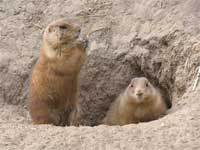 Highly Social: Prairie dogs are highly social animals which live in large towns formed by single families of one male and 2 to 4 females. They have up to 4 pups, one time a year, which are born blind and without fur and need about 30 days of close nurturing by their mother. Recent research indicates that prairie dogs have relatively sophisticated vocal communication abilities, including many of the characteristics of language. Highly Social: Prairie dogs are highly social animals which live in large towns formed by single families of one male and 2 to 4 females. They have up to 4 pups, one time a year, which are born blind and without fur and need about 30 days of close nurturing by their mother. Recent research indicates that prairie dogs have relatively sophisticated vocal communication abilities, including many of the characteristics of language.
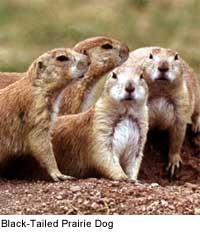 The Black-tailed Prairie Dog (Cynomys ludovicianus), is found in the Great Plains of North America from about the USA-Canada border to the USA-Mexico border. It isnamed for the black tip of its tail. Black-tailed prairie dogs have small ears, short tails, and muscular legs. Their fur is buff-colored and often blends with the earth in which they dig their burrows.Unlike some other prairie dogs, these animals do not truly hibernate. The Black-tailed Prairie Dog can be seen above ground in midwinter. There is a report of a Black-tailed prairie dog town in Texas that covered 64,000 km² (25,000 sq mi) and included 400,000,000 individuals. The Black-tailed Prairie Dog (Cynomys ludovicianus), is found in the Great Plains of North America from about the USA-Canada border to the USA-Mexico border. It isnamed for the black tip of its tail. Black-tailed prairie dogs have small ears, short tails, and muscular legs. Their fur is buff-colored and often blends with the earth in which they dig their burrows.Unlike some other prairie dogs, these animals do not truly hibernate. The Black-tailed Prairie Dog can be seen above ground in midwinter. There is a report of a Black-tailed prairie dog town in Texas that covered 64,000 km² (25,000 sq mi) and included 400,000,000 individuals.
Prior to habitat destruction, this species was probably the most abundant prairie dog in central North America. This species was one of the animal species described by the Lewis and Clark Expedition in the journals and diaries of their expedition.
Keen Senses: Prairie dogs rely on keen hearing, excellent eyesight and a communal warning system for protection against predators.
Towns: They are social animals and the areas they inhabit are known as towns or colonies. Town is a good term because, in a way, their towns are much like ours. A dog town may vary in size from an acre to several hundred acres. In the 1800's, dog towns were described as stretching for miles; some extremely large towns are still found in South Dakota.
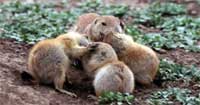 Coteries: A typical prairie dog town consists of groups of prairie dogs that occupy and protect small areas within the town. These groups of prairie dogs are known as coteries, which may be compared to "neighborhoods" of human towns. Individual prairie dogs stay in their own neighborhoods. A typical coterie consists of one adult male, three or four adults females, and their young up to one year of age. The residents of each coterie protect their territory from intruders, including prairie dogs from other coteries within the town. Coteries: A typical prairie dog town consists of groups of prairie dogs that occupy and protect small areas within the town. These groups of prairie dogs are known as coteries, which may be compared to "neighborhoods" of human towns. Individual prairie dogs stay in their own neighborhoods. A typical coterie consists of one adult male, three or four adults females, and their young up to one year of age. The residents of each coterie protect their territory from intruders, including prairie dogs from other coteries within the town.
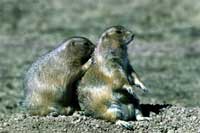 Cooperation: Members of the coterie cooperate with one another. Competition for food and shelter is uncommon within the coteries, and all members occupy a nearly equal social position. Members of the coterie recognize each other with a "kiss." They may also be seen grooming each other, cooperating in the construction of a burrow, aiding each other in defense of the territory, eating together, playing with one another, or standing side by side on a mound of earth. Cooperation: Members of the coterie cooperate with one another. Competition for food and shelter is uncommon within the coteries, and all members occupy a nearly equal social position. Members of the coterie recognize each other with a "kiss." They may also be seen grooming each other, cooperating in the construction of a burrow, aiding each other in defense of the territory, eating together, playing with one another, or standing side by side on a mound of earth.
Communication: Communication between the members of a town is very important and highly specialized. As many as ten different calls have been described, including sounds for warning, defense, territoriality, fear, or fighting. A warning cry from one prairie dog sends all within earshot hustling for their burrows.
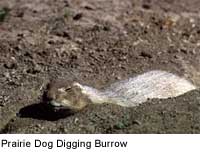 Burrows: Prairie dog burrows have not been studied intensively, but some general features are known. Depth of the burrow system is often governed by the local soils. In deep soil, the burrows may extend downward for ten or more feet, averaging 24 feet of tunnel per entrance. The prairie dogs pack a conical mound of soil around the entrance of the main burrow to serve as a lookout post and as protection against flooding. The entrance tunnel section extends steeply downward for several feet with the next tunnel section being gently inclined, descending down to the nest. The nest chamber is usually lined with grasses. Some tunnels then return to the surface, often with a depressed, crater-like opening marking their terminus. Several burrows may be connected underground. Tunnel plugs are common, but may be quickly re-excavated in emergencies. Burrows: Prairie dog burrows have not been studied intensively, but some general features are known. Depth of the burrow system is often governed by the local soils. In deep soil, the burrows may extend downward for ten or more feet, averaging 24 feet of tunnel per entrance. The prairie dogs pack a conical mound of soil around the entrance of the main burrow to serve as a lookout post and as protection against flooding. The entrance tunnel section extends steeply downward for several feet with the next tunnel section being gently inclined, descending down to the nest. The nest chamber is usually lined with grasses. Some tunnels then return to the surface, often with a depressed, crater-like opening marking their terminus. Several burrows may be connected underground. Tunnel plugs are common, but may be quickly re-excavated in emergencies.
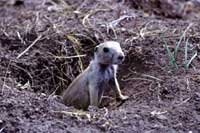 Birth: Prairie dogs only give birth to one litter per year. The breeding season is mid-March to mid-April, with the young being born 4 to 5 weeks later. The size of the litter varies from 2 to 8 young, which are nursed by the mother for about 6 weeks. During May and the early part of June, the young begin to emerge from their burrows for the first time. At this time, yearlings (young from the previous year) and some adults may relocate, leaving the young pups to feel secure both socially and environmentally in the old burrow. When prairie dogs relocate, they take over abandoned holes or dig new holes at the edge of the town. A few may travel miles in search of new areas, but once away form the communal warning system, most are easy prey for predators. Birth: Prairie dogs only give birth to one litter per year. The breeding season is mid-March to mid-April, with the young being born 4 to 5 weeks later. The size of the litter varies from 2 to 8 young, which are nursed by the mother for about 6 weeks. During May and the early part of June, the young begin to emerge from their burrows for the first time. At this time, yearlings (young from the previous year) and some adults may relocate, leaving the young pups to feel secure both socially and environmentally in the old burrow. When prairie dogs relocate, they take over abandoned holes or dig new holes at the edge of the town. A few may travel miles in search of new areas, but once away form the communal warning system, most are easy prey for predators.
Incomplete hibernation: Black-tailed prairie dogs have incomplete hibernation, their activity and appetite are decreased during the winter. They may sleep for many days at a time, but the town is usually active during the milder days of the winter.
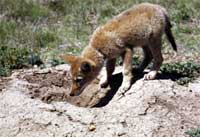 Predators: Common predators of the prairie dog include coyotes, bobcats, eagles, hawks, badgers, and weasels. One member of the weasel family, the black-footed ferret, deserves special mention. They are perhaps the rarest mammals in North America, depending primarily upon prairie dogs for food. Widespread poisoning of prairie dog towns endangered the existence of this interesting mammal. Predators: Common predators of the prairie dog include coyotes, bobcats, eagles, hawks, badgers, and weasels. One member of the weasel family, the black-footed ferret, deserves special mention. They are perhaps the rarest mammals in North America, depending primarily upon prairie dogs for food. Widespread poisoning of prairie dog towns endangered the existence of this interesting mammal.
Other animals may also be found in prairie dog towns. Snakes, including rattlesnakes, are fond of using abandoned burrows as homes, as are burrowing owls, birds with long legs and short tails. The owls can sometimes be seen standing on a mound in the midst of a prairie dog colony, creating little or no disturbance among the other inhabitants of the town.
---------------------------------------------------------------------------------------------------------------------------
Ecological Heroes
A keystone species: Ecologists consider this rodent to be a keystone species, for multiple reasons. They are an important prey species, being the primary diet in prairie species such as the Black-footed Ferret, the Swift Fox, the Golden Eagle, the Badger, and the Ferruginous Hawk. Other species, such as the Mountain Plover and the Burrowing Owl also rely on prairie dog burrows for nesting areas.
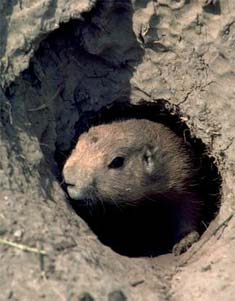 Habitat Helper: Even grazing species, such as Bison, Pronghorn and Mule Deer have shown a proclivity for grazing on the same land used by prairie dogs. It is believed that they prefer the vegetative conditions after prairie dogs have foraged through the area. Habitat Helper: Even grazing species, such as Bison, Pronghorn and Mule Deer have shown a proclivity for grazing on the same land used by prairie dogs. It is believed that they prefer the vegetative conditions after prairie dogs have foraged through the area.
Helpful tunnels: Prairie dog tunnel systems are believed to help channel rainwater into the water table to prevent runoff and erosion, and also can serve to change the composition of the soil in a region by reversing soil compaction that can be a result of cattle grazing. The tunnels have separate rooms for sleeping, eating, babysitting, and just sitting.
Prairie dogs are also known to control the populations of several weed species, such as mesquite, which has been found to overrun some lands where prairie dogs are no longer found.
Extermination: Despite their ecological importance, prairie dogs are frequently exterminated from ranchland, being labelled as a pest because they are capable of damaging crops, and often clear the immediate area around their burrows of most vegetation. Their habitat has been fragmented, and their numbers have been greatly reduced. The Utah prairie dog was listed as an endangered species but due to pressure from land owners it was downgraded to a threatened species and their population continues to decline There are only an estimated 4,000 animals left in the wild. Likewise, petitions have been made to protect the Gunnison's prairie dog, but pressures from land owners has slowed the process, despite what is believed to be a 90% decline in their historical population. The largest remaining community is comprised of Black-tailed Prairie Dogs, and though the United States Fish and Wildlife Service determined that they were species that warranted a recovery plan and protection as an endangered species, there are currently no plans to do so.
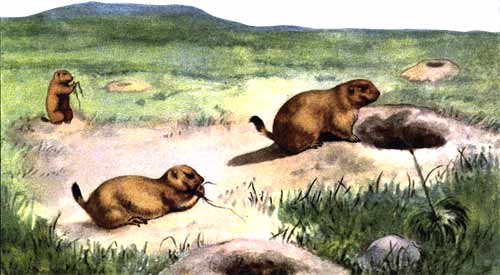
All text is available under the terms
of the GNU Free Documentation License
|